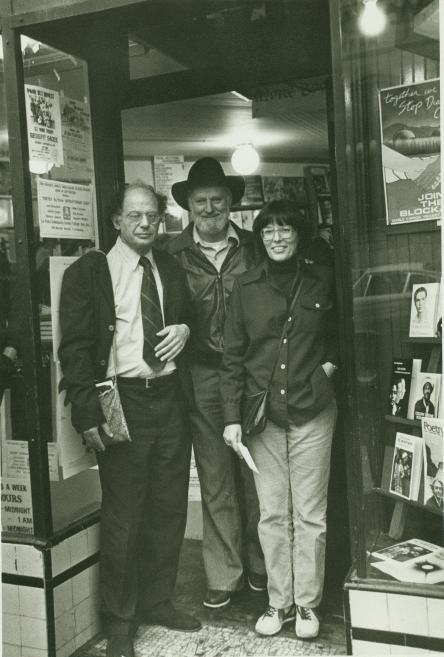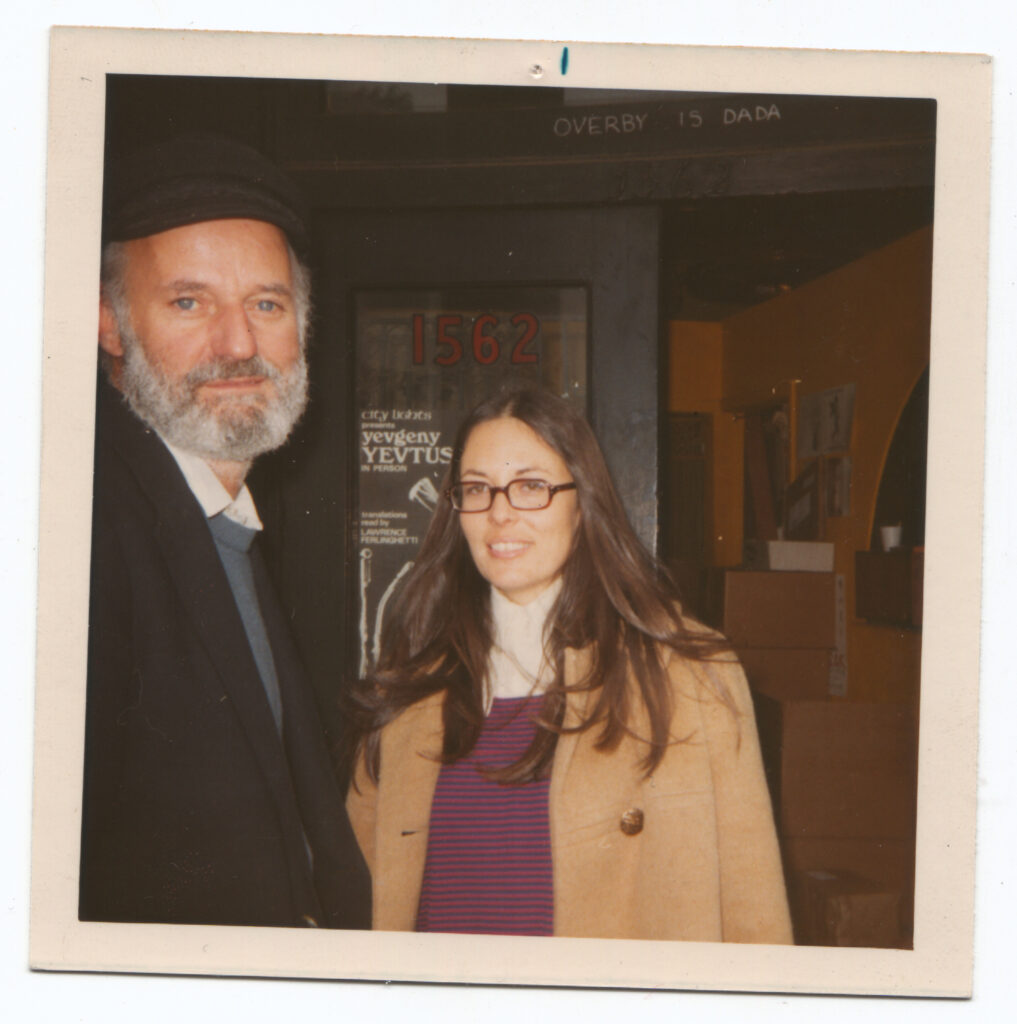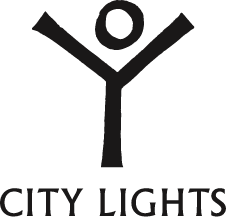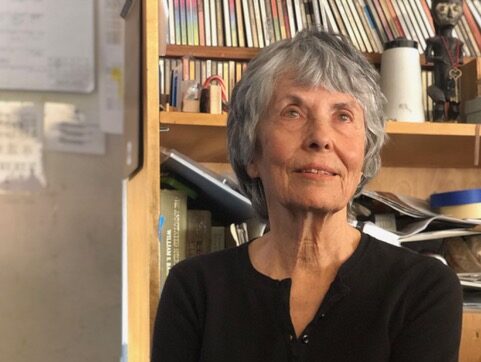While Lawrence Ferlinghetti certainly deserves all of the accolades he’s received, the fact of the matter is there would literally be no City Lights without Nancy Peters. Beyond shepherding City Lights through various fiscal crises and providing the steady anchor that allowed Ferlinghetti to travel the world as a poet and activist, Nancy’s vision as an editor and acumen as a publisher were a vital key to the success and longevity of City Lights Publishers.
This interview was conducted in March 2021 and originally appeared on our tumblr blog. We’re reposting it here because we love it and want it to have permanent space on our new website. Enjoy! (photo of Nancy Peters by Forrest Gander)
How did you come to know what City Lights was? How did you meet Lawrence Ferlinghetti?
Nancy Peters: In Greece in the early 1960s, I became friends with Nanos Valaoritis and Marie Wilson who were at the center of an international bohemian/surrealist community. They had a large home which was always full of traveling writers and artists whom they made welcome. The Beat writers were among their guests, and City Lights was frequently talked about as a place everyone would meet up someday. I met Philip Lamantia there and in 1965 he introduced me to Lawrence in Paris at one of Jean-Jacque Lebel’s anarcho-surrealist festivals of free expression. Before a riotous crowd Lawrence gave a show-stopping rendition of his “Lord’s Prayer.” I was impressed by his powerful stage presence. Later that year, when Philip and I were living in Andalusia, Lawrence wrote Philip, asking for a selection of poems for a Pocket Poets Series volume. We corresponded some while we were putting the book together, but I didn’t see him again until 1971 when I moved to San Francisco.
I’d been working as an executive-trainee librarian at the Library of Congress in the fall of 1968. In April, Martin Luther King was assassinated and the impassioned protests that ensued left Washington neighborhoods in ruins. There was shockingly little assistance to residents from the government and my part of the city was under military surveillance, helicopters hovering over my apartment through the night. A Moratorium to End the War in Vietnam took place in Washington the following year. Over 750,000 people peacefully demonstrated. In a small way, I was involved in the planning and, during the protests, my apartment was crammed with fellow activists.
The Library of Congress was an amazing, fascinating place with compatible co-workers from all over the world—thousands of book people all in one place. However, the mission of the Library is to serve Congress, and the institution was a huge conservative bureaucracy serving a conservative and ineffective Congress as I saw it. I believed that if I stayed there I would have little contact with actual books or opportunities for civic activism.
So I moved to San Francisco, where Philip was living and urging me to come, and spent an enormous amount of time at City Lights while I was job hunting. It seemed like paradise, such a stimulating atmosphere where people could sit down to read, share ideas, and have conversations about books, politics, art. One day in early 1971 when I was walking down the street in North Beach, Lawrence hailed me and asked if I would like to help him with a bibliography of Allen Ginsberg’s writings. After just a brief meeting at the publishing office, Lawrence went to Europe and his editorial assistant Jan Herman suddenly decided to move to Germany. Jan showed me how all the editorial work was done in the office, told me Lawrence “wouldn’t mind,” and so I found myself beginning an exciting new career in publishing.
The mission of the Library is to serve Congress, and the institution was a huge conservative bureaucracy serving a conservative and ineffective Congress as I saw it. I believed that if I stayed there I would have little contact with actual books or opportunities for civic activism.

What was your experience taking over as executive director and co-owner in 1984?
The store back then employed seven people: six men at the bookstore and one woman (me) at the publishing branch. So “executive director” is far too grand a title. City Lights was a small, failing organization by 1982. The store was not founded to make profits for the owners and it never did make a profit. Breaking even was the goal. But every year the losses mounted and there came a time when there were very few books left on the shelves. No one had seen a customer venture downstairs to the lower part of the store for many months.
At the time, Lawrence was immensely popular and in great demand as a performer and a speaker, so he was traveling much of the time, visiting foreign colleagues, living abroad, finding new writers to translate. At this low point in the store’s history Lawrence told me in a frustrated moment that if I’d like to own City Lights, he would give it to me outright if I would run the business, freeing him to do all the other things he wanted to do. I declined, but told him I would be honored to be his partner. Theft was seriously addressed, and a protracted payment plan was agreed to by Book People, the East Bay employee-owned distributors who extended us credit for a generous period. Savvy booksellers Richard Berman and Paul Yamazaki headed the re-stocking plan. The three of us would go every week to Book People and Lou Swift Distributors to collect enough books to sell the following week. As time went on, everybody at the store consulted book catalogs and took on the responsibility for buying subject sections. I envisioned a participatory structure. If not a co-op, I wanted a bookstore where all the staff had responsibilities and power.
Why the decision not to have multiple bookstore locations around SF?
At one time we seriously considered additional locations. We explored sites in San Francisco’s Mission district and visited city officials in San Jose to talk about a second store there. But our resources were limited, and we were concerned about the time and money that would be required to create a sister store that would embody the same spirit and ethic as the original. During my time as director, the evolving challenges from chain stores and especially Amazon made beginning a new store a very risky enterprise. In retrospect, so many independents were closing that we decided to invest in our present, iconic location. In retrospect I think it was a good decision after watching attempts by other stores fail to duplicate their success elsewhere.
At this low point in the store’s history Lawrence told me in a frustrated moment that if I’d like to own City Lights, he would give it to me outright if I would run the business, freeing him to do all the other things he wanted to do. I declined, but told him I would be honored to be his partner.

How has North Beach changed, how has it stayed the same? With the exodus of Big Tech and falling rents, how do you think that will affect North Beach and San Francisco in general in the future? Will there be “a rebirth of wonder”?
North Beach when I came to SF was a small bohemian village, where neighbors shared meals on their flat rooftops watching the sun set over the Bay. My rent was $125 a month, cheap even then. City Lights and the Discovery Bookstore (used books) next door to Vesuvio were key places to spend an evening. Two large Italian grocers delivered (no charge) bags of groceries up four flights of stairs to my apartment. The neighborhood was full of inexpensive Basque, Italian, and Chinese restaurants, and many cafes, many of which seemed unchanged since the 19th century. Change happens, and City Lights is well prepared for the future. It’s never easy to predict how things will develop, but the feeling of a lovely Mediterranean town persists, with the wooden buildings painted pastel colors, and the shimmering sea light on misty days. I feel certain that the light of City Lights will prevail for a long time to come.
Do you feel that your gender had any impact on your experience during your 23 years as director? Do you have any comments about women in bookselling or publishing in general?
Gender always has an impact. The Beat movement was certainly male focused. Even though the undaunted Diane di Prima was recognized, she was never enthusiastically supported by the inner nucleus of Beat poets. It was a long time before the Beat women came into their own. From the start, Lawrence, who insisted he wasn’t a Beat, had eclectic tastes and was open to women’s poetry. He admired Marianne Moore and Edna St. Vincent Millay as much as he did T.S. Eliot, Jacques Prévert, and Allen Ginsberg. In the Pocket Poets Series, he’d published di Prima and, very early in the series, both Marie Ponsot and Denise Levertov.
Women’s rights and opportunities are always vulnerable and cyclic. The Women’s Movement of the 1970s was very powerful and widespread, its impact on women’s lives enormous. At City Lights we hired more women; we published more women. There have always been outstanding women in publishing and bookselling, and during that time increasingly more women writers were published, reviewed, and were given accolades and awards. Women opened general bookstores and women’s bookstores, founded feminist and lesbian presses. It was a thrilling development, to see so many marginalized writers, and not just women, finding established publishers or creating their own presses. Together they created a larger, much more diverse national literature.
I’ve had the pleasure of working with many talented women at the bookstore. And in the publishing branch: Stella Levy, Kim McCloud, and Patricia Fujii. Gail Chiarello collected and edited our bestselling Bukowski stories. Annie Janowitz proposed the timely Unamerican Activities, and Amy Scholder brought us classics by Karen Finley, Rebecca Brown, and others. I’m happy to say that Amy Scholder is again working with City Lights as an editor.
It was a thrilling development, to see so many marginalized writers, and not just women, finding established publishers or creating their own presses. Together they created a larger, much more diverse national literature.
When did you meet the now current publisher and executive director Elaine Katzenberger? What was her position at the bookstore? When did you know that she was the right person to take over as director?
Ah, Elaine, the woman who can do everything! Elaine began at the bookstore sales counter, then reorganized files and the store accounts, and very soon excelled as a book buyer. She had a great feeling for good writing, so I asked her to become an editor and she immediately began adding excellent books to City Lights’ list. She’s smart, witty, multitalented, and politically astute. We are very lucky to have her at the helm.
What is your understanding or vision of what of City Lights is and what it could be? How has Lawrence’s passing impacted this?
Lawrence’s democratic inclusiveness made him the best-selling poet in the U.S. His moral principles, his courage and resilience are a model to be emulated. He conceived City Lights as an educational institution that would open minds to explore and relate to the world through books. “One guy told me he’d got the equivalent of a Ph. D just sitting in the basement reading all our great books,” he often reminded us.
His “literary gathering place” was to be a fulcrum of San Francisco cultural experience, where our bookselling and publishing could amplify the voices of diverse experiences, connect with other creative communities, and serve as a center of dissent and, at the same time, a force for creating a better society.
Lawrence’s vision will continue to be our guiding light. An optimistic realist, he believed that City Lights would long endure as the co-creation of all the dedicated people who work here and make it what it is.

